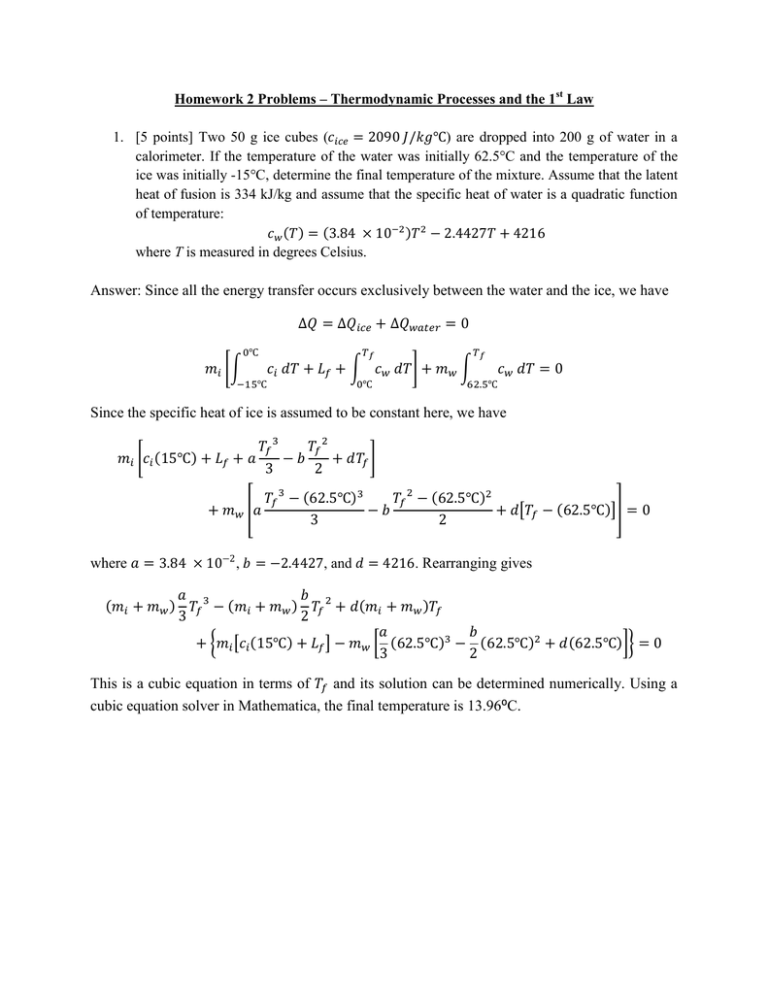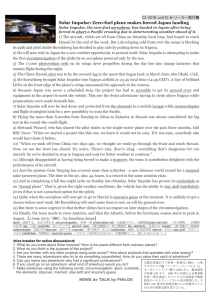
Homework 2 Problems – Thermodynamic Processes and the 1st Law
1. [5 points] Two 50 g ice cubes (
) are dropped into 200 g of water in a
calorimeter. If the temperature of the water was initially 62.5°C and the temperature of the
ice was initially -15°C, determine the final temperature of the mixture. Assume that the latent
heat of fusion is 334 kJ/kg and assume that the specific heat of water is a quadratic function
of temperature:
( ) (
)
where T is measured in degrees Celsius.
Answer: Since all the energy transfer occurs exclusively between the water and the ice, we have
[∫
∫
]
∫
Since the specific heat of ice is assumed to be constant here, we have
[ (
)
]
(
[
where
(
,
)
(
{
[ (
)
(
)
(
]
(
[
)]]
. Rearranging gives
, and
)
)
)
[ (
)
(
)
(
)]}
This is a cubic equation in terms of
and its solution can be determined numerically. Using a
cubic equation solver in Mathematica, the final temperature is 13.96⁰C.
2. [10 points] A sample of an ideal gas goes through the process shown below. From A to B, the
process is adiabatic; from B to C, it is isobaric with 100 kJ of energy flowing into the system
by heat. From C to D, the process is isothermal; from D to A, it is isobaric with 150 kJ of
energy flowing out of the system by heat.
a. Determine the difference in internal energy between A and B.
b. Determine the net work done in the entire cycle.
Answer: Since
is an exact differential, this implies that
cycle. Therefore, based on the above figure, we can write
[(
)
for the entire thermodynamic
as
(
)
Since the path from C to D is isothermal, then (
thermodynamics, the change in internal energy from B to C is
(
)
(
)]
)
(
. Using the first law of
)
Using the first law of thermodynamics, the change in internal energy from D to A is
(
)
(
)
Therefore, we have
[(
)
(
)
(
)]
The net work is given by
(
(
)
(
)
)
(
(
)
)
(
)
3. [10 points] Measured heat capacities of solids and liquids are almost always at constant
pressure, not constant volume. In this problem you will see why by estimating the pressure
needed to keep volume fixed as temperature increases, as follows:
a. Suppose that we slightly increase the temperature of a material at constant pressure.
The fractional increase in volume per unit change in temperature (when the pressure
is held fixed) is called the coefficient of thermal expansion, defined as
(
)
Write the change in volume,
, in terms of dT and .
b. Suppose that we slightly compress the material, holding its temperature fixed. The
fractional change in volume per unit change in pressure (when temperature is fixed)
is called the isothermal compressibility , defined as
(
)
Write the change in volume,
, in terms of dP and .
c. Suppose that you compress the material just enough in part (b) to offset the expansion
in part (a). Show that
(
)
( )
(
)
) for an ideal gas and check that the three expressions
Compute , , and (
satisfy the identity derived above.
d. For water at 25⁰C,
and
. Suppose you
increase the temperature of water from 20⁰C to 30⁰C. How much pressure must you
apply to prevent it from expanding? Repeat the calculation for mercury, for which (at
25⁰C)
and
. Given the choice, would
you rather measure the heat capacities of these substances at constant or at constant
P? Defend your answer.
Answer:
For a thermal expansion process at fixed pressure, we have
(
)
For a thermal compression process at fixed temperature, we have
(
)
If these two processes are to result in no net change in volume, then
(
)
( )
(
)
and therefore,
For an ideal gas
(
(
)
(
)
)
Treating the temperature change as approximately infinitesimal, the required pressure change for
water would be
(
)
(
)
(
)
Similarly, for mercury,
(
)
To measure , we would need to keep the volume fixed while increasing the temperature by at least
a few degrees. As just shown, this requires fairly large pressures. Thus, it’s much easier to stay at
atmospheric pressure and simply measure .
4. [10 points] Heat capacities are normally positive, but there is an important class of
exceptions: systems of particles held together by gravity, such as stars and star clusters.
a. Consider a system of just two particles with identical masses orbiting in circles about
their center of mass. Show that
This result is known as the virial theorem. Suppose you add some energy to this
system and wait for the system to approach equilibrium. Does the average total
kinetic increase or decrease?
b. Use kinetic theory to show that the total energy of the star and heat capacity of the
star should be
( )
What is the meaning of the negative heat capacity for the star?
c. The total gravitational potential energy for a star of mass and radius
is
(Note that the gravitational potential energy is negative since gravity is an attractive
force). Use the virial theorem to show that
Estimate the average temperature of the sun, whose mass is
kg and whose
radius is
m/ Assume, for simplicity, that the sun is made entirely of protons
and electrons.
Answer:
(a) For two objects orbiting in a circle around their center of mass, the kinetic and potential
energies of the system are
(
)
The attractive force between the two particles is given by
⃗
( )
Since the particles are moving around a common center of mass, the attractive force is equal
to the centripetal force
(
)
(
)
(
)
(
)
The total energy of such a system is
Thus, the total energy of the system is directly related to the kinetic energy. Therefore,
increasing the total energy decreases the kinetic energy.
(b) Since the total energy is directly related to the kinetic energy, then kinetic theory (assuming
monatomic molecules) states that
This means that when a star cluster loses energy via heat, its temperature actually increases.
Likewise, when a star gains energy via heat, its temperature actually decreases. This is
consistent with the idea that when energy is taken away from the star cluster system, it
descends to a lower orbit causing the orbital velocity to increase, due to angular momentum
conservation. Since velocity is related to the temperature due to kinetic theory, as we take
energy out of the system, its temperature increases.
(c) Using the virial theorem, we have
(
)
Solving for the temperature gives
The factor M/N is the mass per particle, which is approximately half the mass of a proton
(since the electrons are substantially less massive than the protons). Thus, we have
)(
(
(
)(
)
)
(
)
5. [7.5 points] Consider a uniform rod of material whose temperature varies only along its
length in the -direction. Assume that the only motion of energy is heat conduction within
the rod (no energy enters of leaves the sides) as shown below.
a. By considering the heat flowing from both directions into a small segment of length
, derive the heat equation
where
, is the specific heat of the material, and is its density.
b. Assuming that
is independent of temperature, verify (by substitution) that a
solution to the heat equation is
(
)
(
)
√
where is a constant background temperature and is any arbitrary constant.
c. Plot this solution as a function of , for several values of . Interpret this solution
physically, and discuss in some detail how energy spreads through the rod as time
passes.
Answer:
(a) Consider a segment of the rod, centered on point with width . The rate of heat flow
into this segment from the left, according to Newton’s law of heat conduction, is
(
)
where is the cross-sectional area of the rod. Similarly, the rate of heat flow into the
segment from the right is
(
)
Thus, the total rate of heat flow into the segment is
[(
)
(
)
]
Rewriting the above equation in terms of heat capacity (
) gives
the rod (
Taking the limit
) and the density of
we obtain
(b) To check the trial solution,
(
)
[
√
]
we just evaluate its derivatives
[
]
√
(
)
(
√
(
√
(
)
[
[
)
])
]
[
√
√
(
)
[
]
(
)
Therefore, the trial solution is indeed a solution to the heat equation.
(c) The plot of the solution at 8 different times is given below.
[
]
]
Physically, this solution corresponds to a “pulse” of excess energy that is placed
at
at time
. At
, the excess energy is all at the same place, so the
pulse is infinite high and narrow. It then spreads our according to Newton’s law
of heat conduction, quickly at first (when the temperature gradients are large) and
slowly later on (when the temperature gradients are small). As
the pulse
becomes infinitely wide, as the rod’s temperature becomes uniform.
Bonus: [5 points] Consider the free expansion of gas into a thermally insulated vacuum as shown
below. Prove that the adiabatic equation of state is not valid for this non-equilibrium adiabatic
process.
Answer: This can be derived by a proof by contradiction. Let’s suppose that the adiabatic equation of
state does hold. Using the ideal gas law, we have
Therefore, an increase in volume leads to a decrease in temperature. On the other hand, since this is a
vacuum, kinetic theory tells us that the temperature should remain unchanged (since the internal
energy is also fixed). This leads to a contradiction because the expansion of a gas is not a quasi-static
process.












